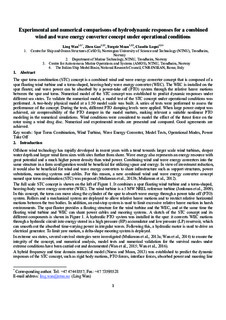| dc.contributor.author | Wan, Ling | |
| dc.contributor.author | Gao, Zhen | |
| dc.contributor.author | Moan, Torgeir | |
| dc.contributor.author | Lugni, Claudio | |
| dc.date.accessioned | 2017-10-25T07:33:03Z | |
| dc.date.available | 2017-10-25T07:33:03Z | |
| dc.date.created | 2016-03-30T08:59:15Z | |
| dc.date.issued | 2016 | |
| dc.identifier.citation | Renewable Energy. 2016, 93 87-100. | nb_NO |
| dc.identifier.issn | 0960-1481 | |
| dc.identifier.uri | http://hdl.handle.net/11250/2462008 | |
| dc.description.abstract | The spar torus combination (STC) concept is a combined wind and wave energy converter concept that is composed of a spar floating wind turbine and a torus-shaped, heaving-body wave energy converter (WEC). The WEC is installed on the spar floater. Wave power can be absorbed by a power-take off (PTO) system through the relative heave motions between spar and torus. Numerical model was established to predict dynamic responses of the STC concept under different sea states. To validate the numerical model, a model test of the STC concept under operational conditions was performed. A two-body physical model at a 1:50 scaling ratio was built. A series of tests were performed to assess the performance of the concept. During the tests, different PTO damping levels were applied. When large power output was achieved, air compressibility of the PTO damper in the model matters, making relevant a suitable nonlinear PTO modeling in the numerical simulations. Wind conditions were considered to model the effect of the thrust force on the rotor using a wind drag disc. Numerical and experimental results are presented and compared. Good agreements are achieved. | nb_NO |
| dc.language.iso | eng | nb_NO |
| dc.publisher | Elsevier | nb_NO |
| dc.rights | Attribution-NonCommercial-NoDerivatives 4.0 Internasjonal | * |
| dc.rights.uri | http://creativecommons.org/licenses/by-nc-nd/4.0/deed.no | * |
| dc.title | Experimental and numerical comparisons of hydrodynamic responses for a combined wind and wave energy converter concept under operational conditions | nb_NO |
| dc.type | Journal article | nb_NO |
| dc.type | Peer reviewed | nb_NO |
| dc.description.version | acceptedVersion | nb_NO |
| dc.source.pagenumber | 87-100 | nb_NO |
| dc.source.volume | 93 | nb_NO |
| dc.source.journal | Renewable Energy | nb_NO |
| dc.identifier.doi | 10.1016/j.renene.2016.01.087 | |
| dc.identifier.cristin | 1347461 | |
| dc.relation.project | Norges forskningsråd: 223254 | nb_NO |
| dc.description.localcode | This is the authors' accepted and refereed manuscript to the article. Locked until 27 February 2018 due to copyright restrictions. Non-commercial. | nb_NO |
| cristin.unitcode | 194,64,20,0 | |
| cristin.unitname | Institutt for marin teknikk | |
| cristin.ispublished | true | |
| cristin.fulltext | postprint | |
| cristin.qualitycode | 1 | |

